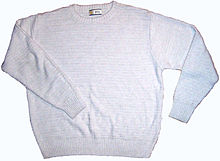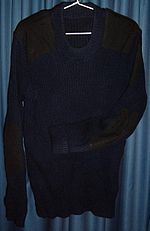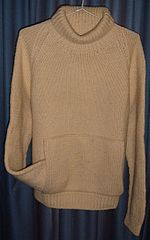- Sweater
-
A sweater, jumper, pullover, sweatshirt, jersey or guernsey is a garment intended to cover the torso and arms. It is often worn over a shirt, blouse, T-shirt, or other top, but may also be worn alone as a top. Sweaters tend to be, and in earlier times always were, made from wool; however, they can be made of cotton, synthetic fibers, or some combination thereof. Sweaters are maintained by washing, and the use of a lint roller. A hoodie is a sweatshirt with a hood.
Contents
Types and design
 "Hot dog" Sweater
"Hot dog" Sweater
The term "sweater" is a catch-all for various types of garments. A fundamental division is between a cardigan (which opens in front) and a pullover (which does not). If the sweater has no sleeves, it is generally called a sweater vest or tank top, or, in the UK, very commonly a "sleeveless pullover" which will very usually have a V neck and can be worn semi-formally; in UK parlance such a sleeveless garment would only be called a "tank top" if it had a square or scooped neck and a generally juvenile appearance.; a "vest" in British English refers to the same item as "undershirt" in American English.
A garment of this type was originally named a sweater either because it was designed to absorb sweat,[citation needed] or the garment was designed to promote a sweat during exercise. It has now become a household name, and other styles of garment (as named above) have kept the original term. A thermal shirt is considered a sweater.
Sweater
Even within these groups, there is a great variety of design. All the various types of necklines are found, although the V-neck, turtleneck and the crew neck are the most popular. The waistline is typically at hip height, but can vary significantly. A typical sweater for woman is waist length, slightly overlapping the waist of the pants or skirt. In contrast to the more "skin revealing tops" for women that can be seen today, the sweater remains a conservative garment. A normal waist-length sweater, worn alone, will only show the arms if short sleeved. Although some sweaters are cropped by design and expose the midriff (in more modern styles), the hip height sweater is modest, typically only revealing a slight amount of skin in the back, near the waist, if the wearer is sitting or bending. The sleeve length is likewise variable, ranging from small cap sleeves to short sleeves to three-quarter sleeves to full-length sleeves. The front seam of a cardigan allows for further possibilities, such as a surplice or a bolero jacket. All the hems may have various types of borders, such as picots, ribbing and frills.
One advantage of sweaters is that they conform well to the body without requiring the tailoring as woven garments. For example, shaping such as darts, flares and gores — commonly found in woven blouses, a comparable garment — are rarely needed in sweaters, thanks to the elasticity and drape of knitted fabrics. Even when such shaping is needed, it can be knit into the fabric itself, without requiring seams. However, this very elasticity makes it necessary to use more care when washing.
Nomenclature
In the U.S., any sweater made of pile weave of synthetic fibers such as polar fleece, is called a sweatshirt whether or not it has a zipper. A hooded sweatshirt is commonly known as a hoodie. A sweater with an open front fastened by buttons or a zipper, is called a cardigan. A hockey sweater was, in the early days of ice hockey, recognisable as what people in the 2000s would call a sweater, but has since evolved into a sort of jersey. Thus, in modern-day North American usage, the shirt of an ice-hockey player's uniform is traditionally called a sweater, regardless of the style.
In British English, a sweater is called a jersey, pullover or jumper, the last two terms being the most common name in British English and Australian English. In South African English, a sweater is always called a jersey. Sleeveless pullovers are known in American English and Australian English as vests or sweater vests. In British English they are known as tank tops or slipovers.
A particularly loud, colorful, or decorative sweater has been known in the USA the past twenty years as a "Cosby Sweater", being named after comedian Bill Cosby's penchant for wearing them during the run of The Cosby Show.
Customary wear
Thin sweaters may be worn tucked in to the waistband of trousers; but otherwise, men's sweaters are to be worn untucked. Nonetheless, some individuals, including some television and film actors, have been known for wearing tucked-in sweaters.[1]
Sweaters are a versatile item of clothing and can be worn on top of almost any outfit. Sports sweaters, especially hoodies, are often worn on tops of sports kit while traveling to or from a sports ground. Sweaters can be worn with a dress shirt underneath (and optionally a tie), which has the advantage of allowing the wearer to have the option of removing the sweater when it is uncomfortably warm and still looking presentable in many situations. In the late 20th century the sweater increasingly came to be worn as an alternative to a shirt when finer materials made them more comfortable next to the skin.
Some women's sweaters are meant to be worn belted; a belt or drawstring is sometimes knitted into the sweater itself. Leggings are commonly worn with long sweaters or sweater dresses.
Ice hockey
The uniforms that present day ice hockey players wear are sometimes referred to as "sweaters," although they more closely resemble the jerseys worn in other sports. This is because original uniforms were simply sweaters with the team's logo stitched on the front. However, as technology changed, so did the uniforms as actual sweaters absorbed too much moisture and became weighed down and bulky throughout the course of a game.
See also
References
Categories:- Sweaters
- History of fashion
- History of clothing (Western fashion)
Wikimedia Foundation. 2010.



